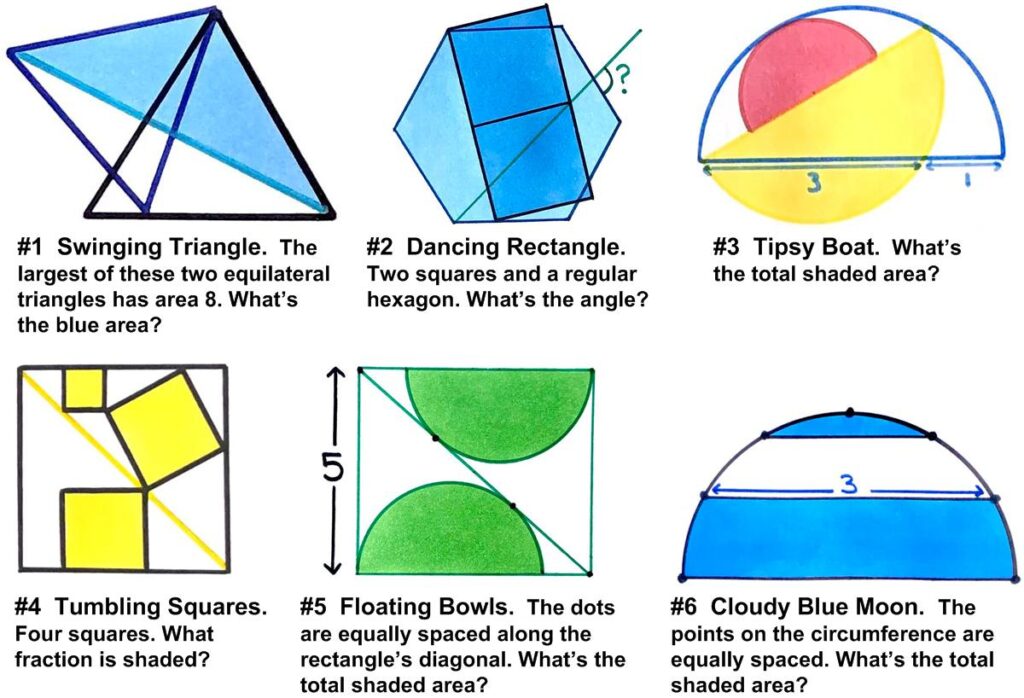 Here is yet another collection of beautiful, stimulating geometric problems from Catriona Agg (née Shearer).
Here is yet another collection of beautiful, stimulating geometric problems from Catriona Agg (née Shearer).
Category Archives: Puzzles and Problems
Two Curious Semicircles
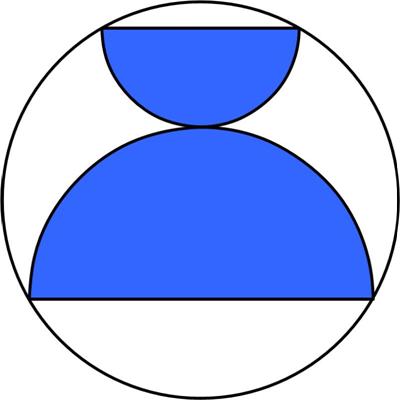 This is a nice brain tickling problem from Presh Talwalkar.
This is a nice brain tickling problem from Presh Talwalkar.
“A circle contains two tangent semicircles whose diameters are parallel chords. If the circle has an area equal to 1, what is the combined area of the two semicircles?”
See the Two Curious Semicircles for solutions.
A Question of Time
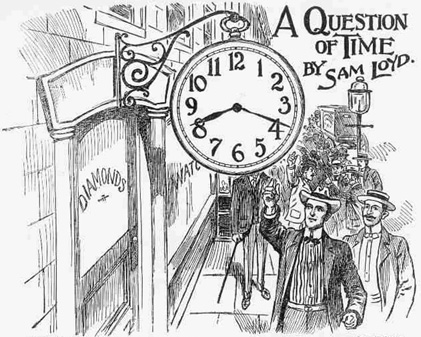 This turns out to be an unambiguous, doable problem from the 19th century puzzle master Sam Loyd. It is based on an observation about jewelers’ signs of the times. I thought I would include Loyd’s narrative in its entirety.
This turns out to be an unambiguous, doable problem from the 19th century puzzle master Sam Loyd. It is based on an observation about jewelers’ signs of the times. I thought I would include Loyd’s narrative in its entirety.
“A CURIOUS paragraph has been going the rounds of the press which attempts to explain why the signs of the big watches in front of jewelry stores are always alike. They are painted upon the dial, apparently in a haphazard sort of a way, and yet they invariably indicate a certain number of minutes past eight. It cannot be attributable to chance, for it would tax one’s credulity to believe that such a coincidence could occur all over the civilized world.
There is no accepted rule or agreement established with the jewelers or sign painters, for careful inquiry proves that few of them are aware of the fact or ever noticed that any two are alike, it would be a marvelous case of unconscious imitation if it is looked upon as a mere custom, accidentally following a pattern set by the originator of the device of the sign of a big watch. In London, where they take pride in such things, I saw several big watches, looking as if they had hung in front of the stores for countless centuries, all indicating the same mysterious time, accompanied by the announcement that the firms were established a couple of hundred years ago. I do not doubt for a moment that some such similar sign can be found at Nuremberg, where the watch originated during the Fifteenth Century.
The discussion seems to have brought out a recognition of the fact that from an artistic point of view, symmetry requires that the hands should be evenly balanced, as it were, on both sides of the face of the watch.
If they are raised too much there is a certain “exasperating, declamatory effect,” which is not altogether pleasing.
The time would be incorrect if the hands pointed at 9 and 3, and at other points would be too low, so, as a matter of fact, and from an artistic point of view, the position is well selected and is one of the points which, with the aid of a watch, can be shown to be possible. It is a fact however, that the mere puzzle of telling what time the watch indicates, has been held up to public gaze for all these centuries without being thought of or solved?
Take your watch and set it to the time indicated, with the hands at equal distances from the six hour, which shows it to he a possible position, and then tell what time of the day it is! …”
See A Question of Time for solutions.
Twisting Beam Problem
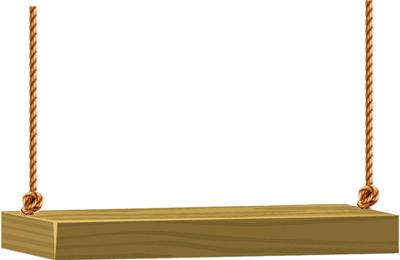 Here is a slightly different kind of problem from the Polish Mathematical Olympiads.
Here is a slightly different kind of problem from the Polish Mathematical Olympiads.
“106. A beam of length a is suspended horizontally by its ends by means of two parallel ropes of lengths b. We twist the beam through an angle φ about the vertical axis passing through the centre of the beam. How far will the beam rise?”
See the Twisting Beam Problem for solutions.
Topple Blocks Puzzle
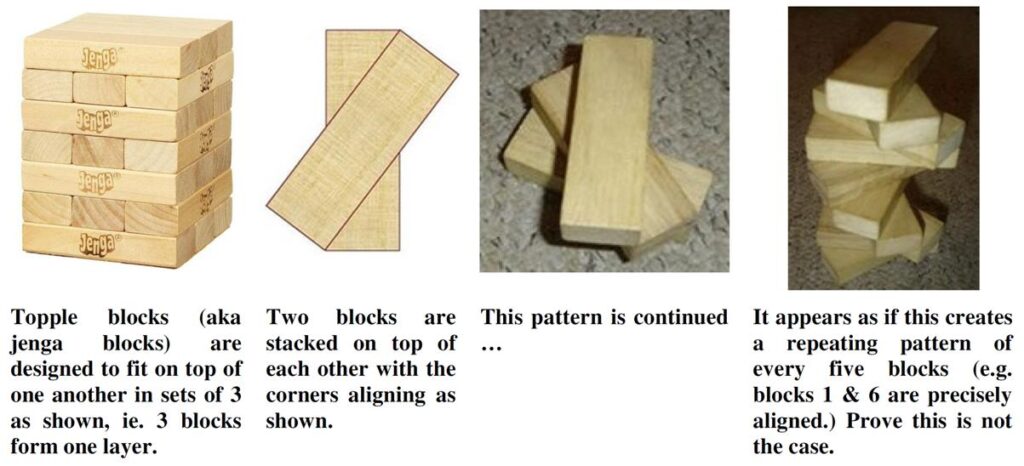
This is another imaginative puzzle from MEI’s MathsMonday. I didn’t know what topple blocks were at first, but a previous MathsMonday puzzle defined them as shown in the first frame. Apparently they derive from the game of Jenga created by Leslie Scott and launched in 1983.
See the Topple Blocks Puzzle
Numbers in New Guinea
 This puzzle from Alex Bellos follows the themes in his new book, The Language Lover’s Puzzle Book, which, among other things, looks at number systems in different languages. (See also his Numberphile video.)
This puzzle from Alex Bellos follows the themes in his new book, The Language Lover’s Puzzle Book, which, among other things, looks at number systems in different languages. (See also his Numberphile video.)
“Today is the International Day of the World’s Indigenous People, which aims to raise awareness of issues concerning indigenous communities. Such as, for example, the survival of their languages. According to the Endangered Languages Project, more than 40 per cent of the world’s 7,000 languages are at risk of extinction.
Among the fantastic diversity of the world’s languages is a diversity in counting systems. The following puzzle concerns the number words of Ngkolmpu, a language spoken by about 100 people in New Guinea. (They live in the border area between the Indonesian province of Papua and the country of Papua New Guinea.)
Ngkolmpu-zzle
Here is a list of the first ten cube numbers (i.e. 13, 23, 33, …, 103):
1, 8, 27, 64, 125, 216, 343, 512, 729, 1000.
Below are the same ten numbers when expressed in Ngkolmpu, but listed in random order. Can you match the correct number to the correct expressions?
eser tarumpao yuow ptae eser traowo eser
eser traowo yuow
naempr
naempr ptae eser traowo eser
naempr tarumpao yuow ptae yuow traowo naempr
naempr traowo yempoka
tarumpao
yempoka tarumpao yempoka ptae naempr traowo yempoka
yuow ptae yempoka traowo tampui
yuow tarumpao yempoka ptae naempr traowo yuow
Here’s a hint: this is an arithmetical puzzle as well as a linguistic one. Ngkolmpu does not have a base ten system like English does. In other words, it doesn’t count in tens, hundreds and thousands. Beyond its different base, however, it behaves very regularly.
This puzzle originally appeared in the 2021 UK Linguistics Olympiad, a national competition for schoolchildren that aims to encourage an interest in languages. It was written by Simi Hellsten, a two-time gold medallist at the International Olympiad of Linguistics, who is currently reading maths at Oxford University.”
Walking Banker Problem
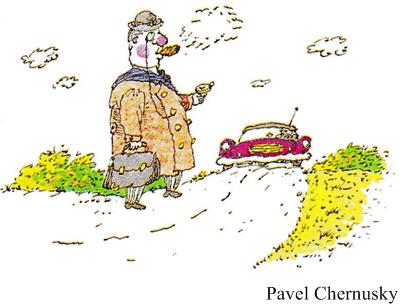 Here is another Brainteaser from the Quantum magazine.
Here is another Brainteaser from the Quantum magazine.
“Mr. R. A. Scall, president of the Pyramid Bank, lives in a suburb rather far from his office. Every weekday a car from the bank comes to his house, always at the same time, so that he arrives at work precisely when the bank opens. One morning his driver called very early to tell him he would probably be late because of mechanical problems. So Mr. Scall left home one hour early and started walking to his office. The driver managed to fix the car quickly, however, and left the garage on time. He met the banker on the road and brought him to the bank. They arrived 20 minutes earlier than usual. How much time did Mr. Scall walk? (The car’s speed is constant, and the time needed to turn around is zero.) (I. Sharygin)”
I struggled with some of the ambiguities in the problem and made my own assumptions. But it turned out there was a reason they were ambiguous.
See the Walking Banker Problem for solutions.
Triangle Quadrangle Puzzle
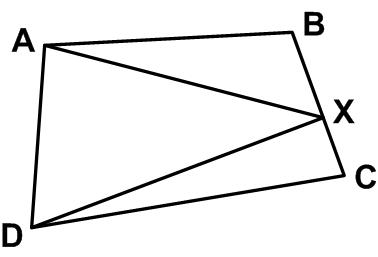 This is another simple problem from Five Hundred Mathematical Challenges:
This is another simple problem from Five Hundred Mathematical Challenges:
“Problem 57. Let X be any point between B and C on the side BC of the convex quadrilateral ABCD (as in the Figure). A line is drawn through B parallel to AX and another line is drawn through C parallel to DX. These two lines intersect at P. Prove that the area of the triangle APD is equal to the area of the quadrilateral ABCD.”
See the Triangle Quadrangle Puzzle
The Pearl Necklace Problem
 This problem comes from the Scottish Mathematical Council (SMC) Senior Mathematical Challenge of 2008:
This problem comes from the Scottish Mathematical Council (SMC) Senior Mathematical Challenge of 2008:
“S2. In Tiffany’s, a world famous jewellery store, there is a string necklace of 33 pearls. The middle one is the largest and most valuable. The pearls are arranged so that starting from one end, each pearl is worth $100 more than the preceding one, up to [and including] the middle one; and starting from the other end, each pearl is worth $150 more than the preceding one, up to [and including] the middle one. If the total value of the necklace is $65,000 what is the value of the largest pearl?”
I included the words in brackets to erase any ambiguity.
See the Pearl Necklace Problem for solutions.
Fashion Puzzle
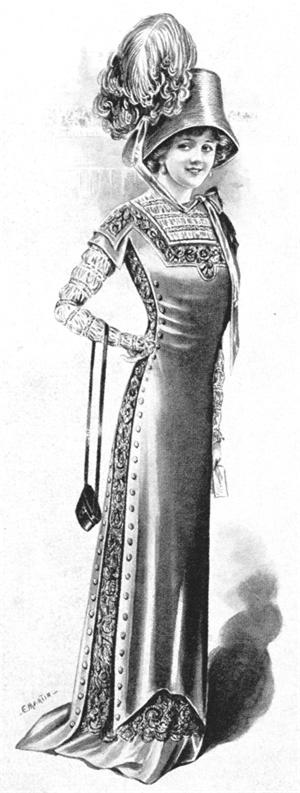 Again we have a puzzle from the Sherlock Holmes puzzle book by Dr. Watson (aka Tim Dedopulos).
Again we have a puzzle from the Sherlock Holmes puzzle book by Dr. Watson (aka Tim Dedopulos).
“On one occasion, Holmes and I were asked to, solve the robbery of a number of dresses from the workshop of a recently deceased ladies’ tailor to the upper echelons of society. Holmes took a short look at the particulars of the case, and sent them all back to the gown-maker’s son with a scribbled note to the effect that it could only be one particular seamstress, with the help of her husband.
However, glancing through my observations some period later, I observed certain facts about the robbery which led me to an interesting little exercise. The stock at the workshop had been very recently valued at the princely sum of £1,800, and when examined after the theft, comprised of precisely 100 completed dresses in a range of styles, but of equal valuation. However, there was no remaining record of how many dresses had been there beforehand. The son did recall his father stating, of the valuation, that if he’d had thirty. dresses more, then a valuation of £1,800 would have meant £3 less per dress.
Are you able to calculate how many dresses were stolen?”
See the Fashion Puzzle for solutions.
